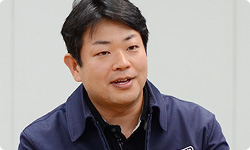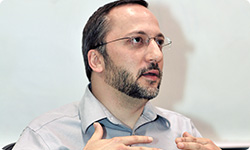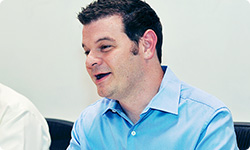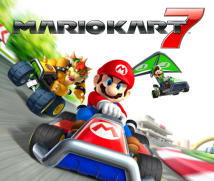2. Starting with Classic Courses
Morimoto-san, when you actually met the Retro staff, did your impression change?
It did. When I actually met them, I thought, “Wow, they’re incredibly cheerful!” That was my reaction, and I was relieved. (laughs)
I believe they were already very familiar with Mario Kart as well, correct? Since they’ve all liked and played Nintendo games for a long time.
Yes. They were very, very knowledgeable about Mario Kart! (laughs)
At the same time, they’d also made Donkey Kong Country Returns and the Metroid Prime series9, and I’ve always been impressed at how amazing the graphics in those were, so I went into that meeting filled with respect for them. 9Metroid Prime series: The series includes three titles: Metroid Prime (Nintendo GameCube, 2003), Metroid Prime 2: Echoes (Nintendo GameCube, 2004), and Metroid Prime 3: Corruption (Wii, 2007). Metroid Prime and Metroid Prime 2: Echoes were also released for the Wii console in 2009 as part of Metroid Prime Trilogy.

What about you, Ishikawa-san?
At first, when I had the opportunity to explain to Retro how we were making the character and kart designs, they asked specific questions like, “Should we make this part this way?” right then and there, their enthusiasm really came across. I was sure then that we’d be able to work together.
First we had Retro come here, to Nintendo, and after that we went to visit Retro.
That’s right. And, we started development just after they’d finished Donkey Kong Country Returns, in December, when everything was beginning to look a lot like Christmas.
Right when you really should have been relaxing. (laughs)
(laughs) Yeah, it was a great time for us to come visit.
Ryan-san, was that your first visit to Japan?
Yes. I enjoyed it. It was a great experience.
What did you think of Japan, the first time you saw it?
I was excited and nervous, all at the same time. Just going to Japan was a lifelong dream of mine; I’d always wanted to go there. Then, too, I’ve always been a very big fan of Nintendo, so it was just an amazing visit. It was great to meet a lot of the different members of Nintendo who have worked on games throughout the years. It was just an amazing experience.
There’s a special difficulty to creating Mario Kart. You have to balance several things: you have to design courses that will make for an interesting racing game, you have to create visuals that will satisfy today’s gamers, and you have to express a feeling of lots of variety within 60 frames per second.10 1060 frames per second: Animation using 60 image frames per second. The more frames there are, the smoother the animation.
That’s it exactly.
But there’s a conflict in that, isn’t there, in creating strong visuals and also showing them at 60 frames per second? How did you resolve that conflict and make this a reality? Morimoto-san? Tom-san? What do you think?
Right. In terms of how we resolved that challenge with Retro, when we created this game, Nintendo produced half the courses and Retro produced the other half. Before they created new courses, we asked that they recreate 16 past courses which we call classic courses .11 We’d put in lots of new elements, such as racing in the sky or underwater , so I think at that point we asked them to include lots of special features you’d only be able to find in Mario Kart 7, instead of simply recreating the courses. Wasn’t that how it went? 11Classic courses: Fresh recreations of courses that appeared in previous Mario Kart games and fit with the style of this game.
Yeah, that’s correct. I thought that was a great way for us to start because we had the knowledge of what the overall course was. That made it a perfect balance of some knowledge we could work with while we were learning the tools and the new methods that EAD uses, some of which were different from Retro in terms of that we hadn’t developed on Nintendo 3DS software before, obviously. So it was a perfect challenge to redo these particular courses and to learn lessons about the development process while we were doing that. Then we could carry that over when we were learning about the design process, about what makes a good course from a design perspective. We also learned that from those courses as well, so I thought it prepared us for making the new courses very well.

So you mean, by beginning with classic courses, you were able to get used to developing Mario Kart, something you hadn’t done before. Since you also learned about the courses and about the unique traits inherent to the Nintendo 3DS system, it turned out to be extremely efficient.
Yes. Tom-san was a very quick learner. In less than two months, when I got careless about things like placing item boxes and course design, he was actually pointing it out to me, “Is it okay if you don’t do this here?” Like that.
Thanks! (laughs) Well, it’s very interesting. As a player of the games, you know what you enjoy, what you think is fun. The challenge for designers is figuring out, “How did they make that fun? What were the steps that I can’t see that created that feeling for me?” So, it was very interesting to talk with the team at EAD that has this long history of Mario Kart.
Something I’ve noticed while I’ve been listening to you is that the feeling of working with somebody for the first time seems to have disappeared very early in the process.
It really did. It was like that with the graphics as well. When we requested the classic course for Luigi’s Mansion 12 , Ryan-san created something of startlingly good quality in a short time. He said, “I may have gone a bit overboard with this. Is that okay?” and I said, “Yes! Yes, please! Keep it up!” (laughs) 12Luigi’s Mansion: An action-adventure game released for the Nintendo GameCube system in September 2001 in Japan.
Ryan-san, you had to build on what EAD had originally created in order to make it more appealing to present gamers. How did that feel?
Yes, it was definitely something that was challenging at first, starting with the Mario Kart DS13 courses and increasing the graphics and the amount of detail for the Nintendo 3DS system. We really wanted to focus and work with EAD to make sure that the impression that the original level gave us was maintained in the new art that we created for the Nintendo 3DS version of Mario Kart. I was actually really, really happy to hear that Morimoto-san and the rest of EAD were pleased with Luigi’s Mansion. That was actually the first course I worked on for the game, and being a fan of Luigi’s Mansion - the Nintendo GameCube game - and Mario Kart, I really wanted to capture the impression that the player had when they went into the mansion in the actual Nintendo GameCube version within the Mario Kart game. I went back and forth between the Nintendo GameCube game and Mario Kart, trying to bring the inside of the mansion as close as I could to the Nintendo GameCube version. 13Mario Kart DS: An action-racing game released for the Nintendo DS system in December 2005 in Japan.
So you went back and forth between the original Luigi’s Mansion and Mario Kart DS, visualising how the players wanted Luigi’s Mansion to look, and tried to get as close to that as possible as you created the course.
Yeah, it was definitely a balance of considering what the Mario Kart DS course and the Luigi’s Mansion game for Nintendo GameCube were, and making sure that when we were finished with that course that it still felt like the player would recognise it as reminiscent of the Mario Kart DS course. So it was always on all the artists’ minds to be careful not to take it too far away from the feel of the original Mario Kart DS version.

It was, in the end, the classic Luigi’s Mansion course that appeared in Mario Kart DS, so you couldn’t get too far away from the Mario Kart DS image. That said, it was important to preserve the balance between that and making it look as great as current gamers would expect it to be.
Our actual development method was to put one designer on each course, and for me to work together with them, talking as we went, so that we didn't stray far from the original course. One more very important thing was that we had constant communication with EAD during the production of our courses and would update them on a weekly basis. Morimoto-san’s feedback and the feedback from other EAD members were very valuable.
Thank you! I’m very relieved to hear you say that. (laughs)
